Lori Robinson's Blog, page 3
February 28, 2023
Birding Africa – A Father/Daughter Trip
Since I was a young girl, conversations with dad were more often than not interrupted by him raising his hand like a stop sign and announcing with great importance, “Listen, there’s a black-throated blue warbler,” or some such name. Cocking his ear toward the noise, and pursing his lips he would call out “pish, pish, pish,” hoping to entice the bird closer. A birder’s universal call, this sound can be perfected by studying The Art of Pishing, (audio CD included) by Pete Dune. A copy of it, along with What Bird Did That? pictures of windshield bird splats accompanied by detailed descriptions of color, contents, and consistency – are among the hundred or so birding books my father owns.
Birding People
There are two kinds of people who sign up for an African safari. Most, myself included, want to see “The Big Five”— lion, leopard, rhino, buffalo, and elephant. The other people are… the birders. So when my father announces he wants to join me on a trip to Africa I have planned for myself, I am delighted, but feel I must clarify, “Dad, you know this is not a birding trip.”
“Fine by me,” he replies, “I won’t even mention my interest in birds to anyone so I don’t interfere with any part of your plans.”
True to his word, for the first part of our journey anyway, he doesn’t mention birds. He doesn’t need to. My dad is never without a pair of binoculars hanging from his neck, and a pencil and local bird list sticking out of his back pocket, ready to identify any flying species.
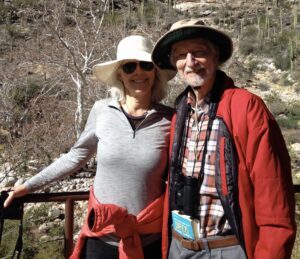 My father and me.
My father and me.At our first stop, we meet up with a group of my friends at a private reserve near Kruger National Park.
“Where is your father?” quickly becomes the group’s mantra, and I am sure to find him, off on his own, whispering into the microphone the identifying characteristics of the bird species he’s filming. In the Northern Transvaal, my friends and I climb among rock cliffs where we discover fresh leopard prints in the sand. Meanwhile, my dad, wearing his favorite one-size-too-large-for-him khaki hat, stalks lanner falcons, red-breasted hornbills, and grey louries.
The group cooks stew and bread in a three-legged “pokipot” over an open fire under the stars while our guide talks about the history of the area, and my dad checks off boxes on his birding list. He is especially excited by “lifers;” those birds he has never seen before.
Birding vs the big fiveFor the most anticipated part of my itinerary, dad and I fly alone to Botswana to visit two different lodges chosen because of their large populations of my favorite animals – cats and elephants.
Wrapped in blankets against the 5:30 a.m. chill, we climb into the open Land Rover for our first wildlife drive. Impatient to get into the bush, I hardly hear Tim, our driver/guide, recite the dos and donts of safari etiquette.
Finally, Tim finishes his diatribe. “So let’s push off,” he says.
“Yes,” I concur, with an enthusiastic clap of my hands.
But before he starts the engine, he turns toward my father and me in the back seat and asks, “Are either of you birders?”
Why… do they always ask that?
“I’m not. I want to focus on mammals, especially lions and elephants,” I respond with an I’m-in-charge attitude, hoping Tim realizes I am speaking for my father and myself.
Then my father murmurs something about… “birder, “ followed by: “But this is my daughter’s trip and I don’t want to ruin it for her, so let’s focus on large animals.”
As I’m thinking how sweet it is of my dad to say this, I hear him add, “But if we see a bird or two that would be great.” A bird or two? Is he joking? Birds are everywhere, they’re inescapable.
Tim’s face lights up as if he just caught up with a long-lost friend, “Oh wonderful, I’m a birder too,” he says. From the detail with which Tim and his new best buddy then compare binoculars, I realize I’m doomed.
A few minutes into our drive we stop. I scan the area but see nothing. Tim points as I catch a glimpse of purple, green, yellow, orange, and blue feathers shimmering in the first morning light. This is a beautiful bird, I admit to myself.
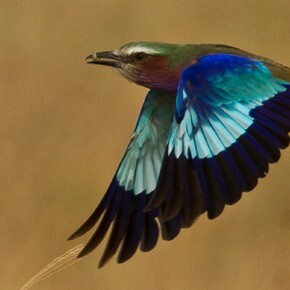 Photo by safari client Henry Holdsworth
Photo by safari client Henry HoldsworthThe lilac-breasted roller is a lifer for my father, and he wants to see the male roll earthward from the sky in his mating dance.
During our two-hour drive, we stop more than a school bus full of kids. We halt and stare at every brown, blue, yellow, big, little, flying, and sitting bird. I listen to discussions of wing spans, beak shapes, and throat colors, and I learn new names like Hammerkop and Bateleur.
An hour and a half, and twelve lilac-breasted roller sightings (among many other bird species) later, we see a pride of seven lions, sleeping belly up, their baseball mitt-size paws facing the sky.
Finally! I rest my elbows on the edge of the vehicle’s door focusing my father’s hand-me-down pair of binoculars on their blood-stained, fly-covered fur. I’m rivited by the lions twitching whiskers, and their full bellies moving up and down with each breath.
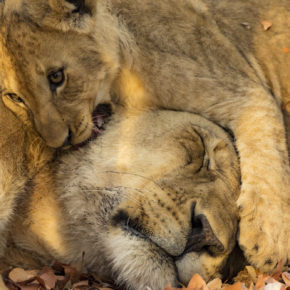 This cub was trying it’s best to wake up the pride. No such luck.
This cub was trying it’s best to wake up the pride. No such luck.After a few minutes, Tim interrupts my big cat trance, “They aren’t going to do anything, so let’s push onward.”
So we can find some more birds which are doing so much, I think to myself. I would rather spend the rest of the day watching these lions sleep.
It’s All about Elephants
Our remaining four wildlife drives at Chitabe Camp follow the same pattern. My need to see anything larger than an eagle is accommodated but lacks the obvious enthusiasm that accompanies any and all bird sightings. I have practically become a birder myself by osmosis alone, so at our next lodge, with only two days left before we go home, I am not taking any chances. I explain to my father, “It is probably obvious by the name of the lodge, “Savute Elephant Camp” that I really want to focus on elephants here.”
“Yes, of course,” he agrees.
For added assurance I find a private guide to lead us on a big-game walking experience.
“We have no interest in seeing birds,” I tell Clive when I hire him. He mentions a rogue bull elephant in the area. “We will try to find him,” he says.
“Perfect.” This man has my interests in mind.
In the single file I follow Clive and the shotgun slung over his right shoulder; my father behind me. When we catch up to the massive grey young bull, Clive’s hand motions us to go slow, be quiet, and stay close.
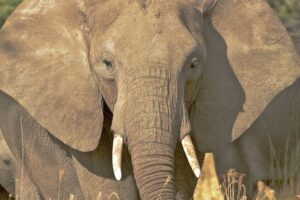
He whispers, “Adolescent male elephants are ousted from the matriarchal herd to find a new group where they can mate, so they can be unpredictable and dangerous.”
Clive’s hand signals us to stop; any further and we would be too close for comfort. The bull moves from one mopane tree to the next, snapping branches like twigs and stripping the red leaves, seemingly oblivious to his audience of three. As I turn to share this adrenaline-pumping moment with my dad, he is nowhere in sight, and the massive creature begins to walk away.
“We can’t follow the elephant until we find your father; I don’t want him getting lost out here,” Clive insists.
I see my father in the distance, half hidden behind a thick bush, a video camera leading him in the opposite direction from the elephant and us. His lens is focused on a tree branch, on top of which sits a lilac-breasted roller.
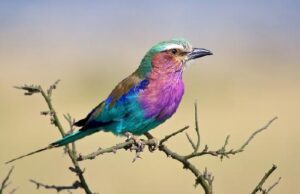
Catching up to him, I plead, “Dad, you have seen hundreds of lilac-breasted rollers already, please can you walk with us, the elephant’s getting away.”
“You’ve seen a hundred elephants already,” he retaliates. We stare at each other for a tension-filled moment, and then we both start to laugh. The noise startles the bird and it flies off, while the elephant disappears into the thick bush.

Back home in the States, I unwrap a gift my father has sent as a thank-you for including him on my African journey. It’s a two-by-three-foot size poster of a lilac-breasted roller.
The post Birding Africa – A Father/Daughter Trip appeared first on Saving Wild.
November 27, 2022
Jane Goodall: Spreading Hope
Jane Goodall: Spreading Hope is her bailiwick. But I’m getting ahead of myself.
On an April day in 1934 a new mother was discharged from a London maternity home, along with her baby girl. Deeming her husband’s Aston Martin race- car too dangerous to transport their firstborn, she enlisted the help of a friend, the owner of a more sedate vehicle. It was my grandfather, Denis Robinson, who conveyed them safely home that day, an act emblematic of their friendship. But no one could have predicted that the baby clasped so carefully in her mother’s arms in Grandpa’s back seat, Valerie Jane Morris-Goodall, would grow up to be one of the world’s most famous conservationists.
Jane Goodall skyrocketed to fame at 29 in the August 1963 issue of National Geographic, captivating readers with her feature article, “My Life Among Wild Chimpanzees.” I was only a few years old at the time, but as a teenager I oc- casionally accompanied my grandfather to functions honoring “Dr. Jane,” and like many women in my Baby Boomer generation, I idolized the courageous young British scientist living in the African bush. Later, after my grandfather died, I spent several years working as the African Adventures Specialist for the Jane Goodall Institute. It was a conversation with Dr. Jane, at one of several 80th birthday parties held in her honor several years ago, that planted the seed for my book, Saving Wild: Inspiration From 50 Leading Conservationists.
According to scientists, we are entering the sixth great mass extinction event, witnessing, as Jon Mooallem writes, “a planet hemorrhaging living things so fast that half of its nine million species could be gone by the end of the century.”
Changing our current environmental course is considered the greatest challenge of our time. Although the window of opportunity to halt, and hopefully reverse, the loss is closing, we can do it. Yet, it’s easy to feel a sense of ecological despair, to lose hope, and to give up trying to make a difference.
Jane Goodall: Spreading HopeIt was in this pessimistic frame of mind that I arrived at Dr. Jane’s birthday party.
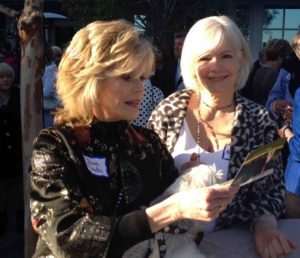 Me with the other Jane (Fonda) at Jane Goodall’s 80th Birthday Party in Los Angeles, California.
Me with the other Jane (Fonda) at Jane Goodall’s 80th Birthday Party in Los Angeles, California.After listening to Jane give an eloquent fundraising speech, I sought her out. “How do you keep going?” I asked. “How do you stay inspired?”
A woman of consistent action and no excuses, even in her ninth decade, Dr. Jane anchored her gold-flecked eyes on mine and replied, “We can’t quit. We have to keep working.”
All over the world, hundreds of thousands of people and organizations are doing just that: working to halt and reverse biodiversity loss, to conserve already threatened species, to assuage the pressures from over-exploitation and climate change. But I couldn’t help wondering if, like me, these people, ever get mired in the doubt and seeming impossibility of it all. And if so, how do they persevere? What is their antidote to ecological despair? Were they, like Dr. Jane, born with an unusual amount of determination, or an exceptional ability to ignore the negative? Do they possess traits that can be learned or copied?
I decided to find out.
I sought out fifty of the world’s leading conservationists, men and women who have devoted their lives to saving some of the most endangered species and the most threatened areas on earth. Among the people I contacted were wildlife film- makers Beverly and Dereck Joubert, elephant experts Daphne Sheldrick, Cynthia Moss and Joyce Poole, and ocean warrior Paul Watson. I spoke with Boyd Varty, who was raised in the African bush, with Kristine McDivitt Tompkins, former CEO of Patagonia, and with Laura Turner, daughter of one of America’s most prominent conservationists. To each, I posed the question I had asked Jane: How do you stay inspired?
The answers I received are more personal, heartfelt, and inspiring than I could have imagined. Not only optimism, but a contagious determination permeates the responses.
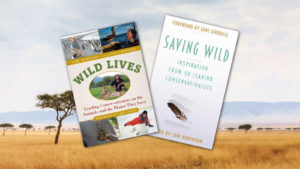 Saving Wild, and Wild Lives – my two conservation books for anyone who needs Hope this Holiday season.
Saving Wild, and Wild Lives – my two conservation books for anyone who needs Hope this Holiday season.That is the gift of the people in my book, Saving Wild. Their determination lifts and holds me up, motivating me to keep trying. It’s my hope that their enthusiasm and dedication will inspire each one of us to work harder at saving the wildlife and wild places that connect us all. And then let’s take Jane’s advice: “Don’t give up.”
Saving Wild, with a foreword from Jane Goodall is a great Holiday gift for anyone who loves animals and could use a little hope.
The post Jane Goodall: Spreading Hope appeared first on Saving Wild.
October 22, 2022
What is the Best Place in Africa For a Safari?
The most common question I get asked by clients is this – “What is the best place in Africa for a safari?” I imagine you’re reading this post because you too would like an answer to that same question.
I’m Lori Robinson. As an African Safari Specialist combining three decades of traveling and living on the African continent you probably imagine I can give a concise answer.
Well, I can. Sort of.
But my answer to ‘what is the best place in Africa for a safari’, depends on YOU.
What does your dream safari look like? What are your must sees. Gorillas, large herds of elephants, the migration? Are you looking to get personal with the Maasai, Bushmen or Hadza? Do you want to sleep under desert stars, canoe down the Zambezi, or are you a birder looking for lifers? Depending on your dreams, my answer varies.
Stay with me, and you will find out what is the best place for you to go on safari
There are nine (out of 54 total) African countries, that offer what I think are spectacular wildlife experiences. Each of them is unique. For instance, Botswana is known for large herds of elephants, East Africa for the migration of 2.5 wildebeest, while a safari in South Africa practically guarantees you will see leopards. Some countries offer land and water experiences, while other areas ensure spending time with traditional tribal peoples, and other countries specialize in bush walking.
At the bottom of the page I’ve listed nine countries in Africa worth your consideration when deciding where to go on safari. I’ve added general pros and cons for a quick comparison of the different countries. For more information I’ve attached links to posts I’ve written on many of the countries.
If you would rather hear about my favorite countries, you can find me describing some of the country’s pros and cons on my YouTube channel.
Whether you check out the list below, or visit my Youtube channel to listen, I compare countries, describing what I love and sometimes dislike about the top safari destinations. It’s worth your time to understand the differences of each so that you choose the best country for your dream safari vacation.
If you want to skip all of this let’s hop on a phone call where I will answer all of your safari questions. I’ve helped hundreds of people choose the best country for a safari, as well as the best Parks within those countries, at the best time of year to get the experiences they hope for.
And I will do the same for you, saving you hours and hours of time searching through reams of information online.
Set up your one hour, $100, phone consult with me, Lori Robinson here: PayPal.me/LoriRobinsonConsults
The Countries offering the Best Safari experience (in alphabetical order) -with Pros and Cons
Botswana
-water element, large herds of Elephants and other wildlife, animals endemic to the area, Bushman tribes, expensive More on what I like about Botswana
Kenya
-Masai and Samburu tribes, wildebeest migration, vast number of big cat and other wildlife, budget to luxury accommodations, mild temperatures, sanctuary visits, iconic African plains (Masai Mara), depending on area there can be huge crowds of tourists More on what I like about Kenya
Watch my YouTube video comparing East Africa to South Africa.
Namibia
-landscape photography, sand dunes, night skies, desert adapted wildlife, Himba tribes crowds in best Parks, less wildlife, can be extremely hot More on what I like about Namibia
Rwanda
-gorillas, , history, rare to see any other animals except gorillas and monkeys, expensive luxury lodging
South Africa
-leopard sightings practically guaranteed, crowds depending on Park, honeymooners destination, City/Safari combo is great, not as many animals as other countries Watch my video comparing South Africa to East Africa.
Tanzania
-Masai and Hadza tribes, iconic African plains (Serengeti), wildebeest migration, vast number of big cat and other wildlife, budget to luxury accommodations, mild temperatures, depending on area there can be huge crowds of tourists, Mt Kilimanjaro trekking More on What I like about Tanzania
Watch my YouTube video about the differences between East Africa and South Africa
Uganda
-Gorilla trekking, Chimpanzee and monkey trekking and sanctuary, other wildlife is there but limited compared to other countries, less expensive then Rwanda
Zambia
-budget to luxury lodging, water element, lots of wildlife, more wild and laid back feel, known for walking safaris, harder to get to the safari areas
Zimbabwe
-budget to luxury lodging, less expensive options for safari, known for walking safaris, water element, good adventure (Victoria Falls activities)/Safari combination, lots of wildlife
Visit my YouTube Channel here.
Set up a one-hour ($100) phone consult here: PayPal.me/LoriRobinsonConsults
The post What is the Best Place in Africa For a Safari? appeared first on Saving Wild.
October 14, 2022
Animal Communication with a Horse – A Sad Story with a Happy Ending
My Animal Communication with a horse named Salvadore was one of my most memorable sessions I’ve had in the seven years I’ve been working in this field.
From the minute I tuned into Salvadore I felt an overwhelming sense of sadness. The feeling was so deep and strong I had to check in with myself to make sure I wasn’t projecting – are these my feelings, or Salvadore’s?
Once Salvadore understood that I was asked to have a session with him because his caretakers were worried about him and wanted to understand his recent behavior, he began downloading information to me.
He told me that he wasn’t heard or respected by the staff where he is boarded, that he doesn’t know who his owner is, and isn’t sure what his routine is. He let me know in no uncertain terms that he hates the facility where he is boarded. Basically he told me nothing was working for him. He felt trapped and angry.
At one point the feeling of being abused came into my consciousness though I wasn’t receiving any images of people hitting Salvadore or hurting him physically.
Underneath this horse’s sad demeanor I sensed a smart, strong and independent character, a very proud being.
When I talked to the owner about my animal communication reading she revealed that Sal’s behavior had become unpredictable, and the grooming staff were now afraid of him. The more afraid people were of Sal, the less time, attention and turn-outs into the pasture he received. The less time Sal had out of his small stall the more cooped up and frustrated he felt. Salvadore was on a downward cycle that I feared would only get worse.
My human client also confirmed that the ownership issue Sal brought up in my reading with him was indeed confusing. Salvadore had recently been sold to a woman (the sister of the person who hired me for this animal communication session) for her niece to ride. “When my daughter leaves for college in two years Sal will be driven across the country to live with his new owner (my sister) who has a large ranch,” the woman who hired me said.
I went back to Sal to tell him all about the plans for his life. I transferred images from my mind to his of a large open pasture surrounded by pine forest, telling him he needed to just hang in there for another two years.
But Salvadore was so adamant that he could no longer live where he currently was. “They even insist on putting a blanket on me every night (he had started to kick the person doing that) which made him overheated,” he told me. He felt there was little hope to get heard in any capacity since the smallest thing, like not wanting a blanket, was not an option.
Sal’s human caretakers laid out the many valid reasons why he could not be moved temporality to a new boarding facility while waiting for his permanent new home. It seemed there was no option for him except to endure two more years at his present facility.
I agonized over that animal communication session for weeks. I would wake in the middle of the night feeling how angry Salvadore was and wondered how many other animals are in similar situations but without such kind and caring caretakers trying to find solutions.
Two months later Sal’s caretaker contacted me to say that things with Sal had gotten so bad he was labeled a danger to others and was not allowed out of his stall at all. I can’t say I was surprised.
But the happy part of this story is what she told me next.
Happy Ending to My Communication with Salvadore
The situation and Sal’s demeanor was so dire, everyone involved decided to fast forward their plans and send him across the country right away.
She told me that ever since he first arrived at his new place in Florida Sal has been perfect. “He is a brand-new horse,” she said. “He gets along with the other horses (in fact has become best friends with one of them) at the farm, and happily lets people ride and groom him, showing none of his previous behaviors.”
After that conversation I checked in with Sal for an animal communication update with him. He told me that in the final days before they decided to expedite their plans to move him to Florida he had become so miserable he had given up on life. He didn’t care if he lived or died.
Although he is still adapting to the new place on the ranch, with other horses, a trainer and owner who is a vet that understands and communicate with him, he is so much happier. His days are full with people and other horses and a few ranch dogs that he shares his new home with.
The gentle, proud, cooperative Salvadore is once again able to shine.
Animals sometimes have no way of communication their needs except for acting out until someone listens. Animal Communication with a Horse, or any other animal, is one of the best methods of creating a relationship that is truly two-sided so that it works for both human and animal. Luckily for Salvadore this story had a happy ending.
Note: This true story was written with permission from Salvadore’s human companions.
The post Animal Communication with a Horse – A Sad Story with a Happy Ending appeared first on Saving Wild.
May 14, 2022
Tanzania Safari – the top 11 things to do
This east African country is a great choice whether you’re taking your first African safari, or you’ve done many safari’s.
While working as the Africa Adventures Specialist for the Jane Goodall Institute I designed and led numerous trips to Tanzania. Besides Gombe Stream, home to Jane Goodall’s infamous wild chimpanzees, my itineraries always included several other areas that I recommend to anyone going to Tanzania. 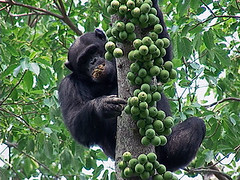 Photo by Bill Wallauer, Jane Goodall Institute
Photo by Bill Wallauer, Jane Goodall Institute
If you have researched safaris you probably know that one of the main attractions for an East Africa safari is the wildebeest migration.
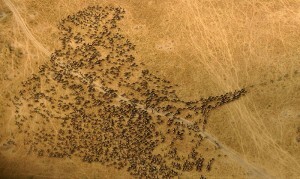 Wildebeest Migration as seen from the air.
Wildebeest Migration as seen from the air.One of the largest animal migrations in the world, over two and a half million wildebeest, zebra and gazelle follow the rains in an annual circle through Kenya and Tanzania in search of new grass.
If seeing the migration is on your tanzania Safari list…[If going to see the migration is your main reason for choosing Tanzania for your safari make sure you read my post about what to expect from the migration. Read the post HERE.]
Migration or not, a Tanzania safari has so much to offer; much of it unique from safaris in other countries. I highly recommend it.
My list of the 11 top experiences for any safari in Tanzania: Hike to see the wild chimpanzees of Gombe National Park Explore the vast Serengeti ecosystemWitness one of the greatest wildlife spectacles on earth (the migration of millions of wildebeest );Journey down into the Ngorongoro Crater (considered one of the world’s natural wonders)Tour Olduvai Gorge—considered the cradle of mankind Drive amongst large herds of elephants in Tarangire National ParkVisit Maasai Tribes in their traditional bomasHave lunch (or stay the night) at Gibbs FarmVisit Tanzania’s southern circuit: Selous and Ruhaha, to escape the crowdsHike KilimanjaroShop at the Maasai Market in Arusha
Do you need help planning your Tanzania (or any other African country) safari? Set up a one-hour phone consult with me to get answers to all your safari questions.
Contact me, Lori Robinson – lorisavingwild@gmail.com
The post Tanzania Safari – the top 11 things to do appeared first on Saving Wild.
Tanzania Safari – Where to go
Working as the Africa Adventures Specialist for the Jane Goodall Institute I designed and led numerous trips to East Africa. My itineraries focused on Tanzania because they included Tanzania’s smallest park, Gombe, home to Jane Goodall’s infamous wild chimpanzees.  Photo by Bill Wallauer, Jane Goodall Institute
Photo by Bill Wallauer, Jane Goodall Institute
Two of three East African countries (Tanzania and Kenya) are known for the wildebeest migration.
 Wildebeest Migration as seen from the air.
Wildebeest Migration as seen from the air.One of the largest migrations in the world, over two and a half million animals follow the rains in an annual circle through Kenya and Tanzania in search of new grass.
[The migration is not what most people imagine. Read my post about it HERE.]
Still, a Tanzania safari has so much to offer; much of it unique. And I highly recommend it.
Here is my list of what I consider to be the top experiences for any Tanzania safari: Hike to see the wild chimpanzees of Gombe National ParkExplore the vast Serengeti ecosystemWitness one of the greatest wildlife spectacles on earth (the migration of millions of wildebeest);Journey down into the Ngorongoro Crater (considered one of the world’s natural wonders); andTour Olduvai Gorge—the cradle of mankind and the beginning of Jane Goodall’s journey to GombeDrive amongst large herds of elephants in Tarangire National ParkVisit the Maasai Tribes in their traditional bomasHave lunch (or stay the night) at Gibbs FarmVisit Tanzania’s southern circuit Parks, Selous and Ruhaha, to escape the crowdsHike KilimanjaroShop at the Maasai Market in Arusha
Need help planning your Tanzania (or any other African country) safari? Set up a one hour phone consult with me to get answers to all your safari questions.
Contact me, Lori Robinson – lorisavingwild@gmail.com
The post Tanzania Safari – Where to go appeared first on Saving Wild.
May 8, 2022
#1 Tip for Attracting Birds to your Backyard
I’ve planted natives, added water features, and put out bird seed in the hopes of attracting birds to my backyard. As a result, my California cottage garden is full of bird activity and song every day.
But there is one thing I recently learned that tops all others for attracting birds to a backyard.
~~~
As I write this, it’s spring, and it’s raining catepillars. Seriously, I’ve just come inside from working in my garden to find four of the pin-sized butterflies-in-the-making hitching a ride on my clothing.
I’m thrilled.
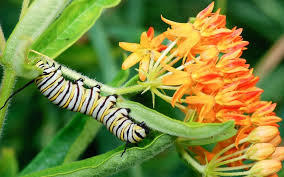
Why? Because although I’ve never been particularly drawn to caterpillars, I love birds. And what I recently learned is the majority of bird species rely on caterpillars (not seeds) for sustenance. Especially for feeding their babies.
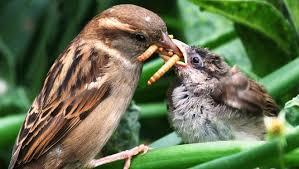 Birds rely on caterpillars, not seeds, to feed their offspring.
Birds rely on caterpillars, not seeds, to feed their offspring.
Bird parents need hundreds of the wriggling creatures a day to feed a nest full of growing fledglings. Having alot of caterpillars in the garden means I’ll be able to help sustain the breeding birds. Our feathered friends need the catepillars for their main source of nutrition.
If you too are a bird lover and you want to attract more birds to your backyard then the question you should be asking yourself is this: How do I get more catepillars in my garden?
I will tell you after I step outside to gently remove the wriggling creatures from my shirt and pants and place them on some leaf mulch.
OK, I’m back.
So, how do you support catepillars in order to attract more birds to your garden?
The good news is that there is one main thing you can do to help birds thrive. You can grow a keystone native tree in your garden.
A one-hundred-year-old oak embraces the back patio of my small California cottage. Its branches almost graze my bedroom sliding doors, comforting me when I sleep.
Now that I’ve learned about the oak’s role as food and housing for over 400 species of catepillars my already immense respect and love for the resident tree has quadrupled.
Oaks (Quercus) are a keystone tree that will go a long way to helping your avian visitors and adding biodiversity to every garden. Depending on the area you live in other keystone species include the cherry (Prunus), and willow (Salix). Those, as well as birches, cottonwoods, and elms are the top woody producers in the USA and best for caterpillars.
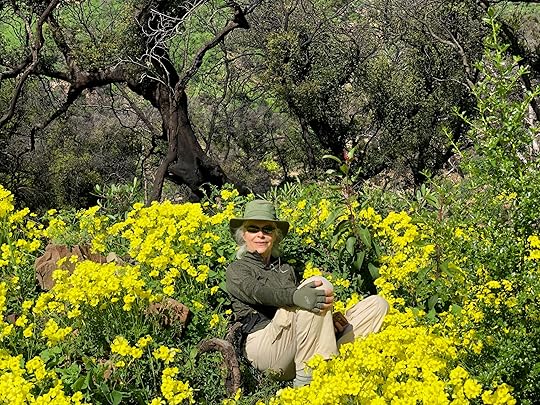 Find native plant inspiration for your garden along your local hiking trails.If you are thinking – I don’t have room for a Huge tree in my garden – read on.
Find native plant inspiration for your garden along your local hiking trails.If you are thinking – I don’t have room for a Huge tree in my garden – read on.If you don’t have room for a tree, you can plant herbaceous natives. Goldenrods, asters, and sunflowers (top three to plant in the US) also provide shelter and food needed for insects that feed birds.
When keystone species are removed from an ecosystem (your garden is an ecosystem) the arch of that system falls down. The food web falls apart. And the wildlife suffer.
Adding only one, or a few, of these native plant powerhouses will go a long way towards helping our wild friends, making your garden more eco- friendly and increasing biodiversity on this planet.
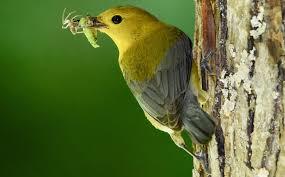 96% of bird species rely on insects for their nutritional needs.
96% of bird species rely on insects for their nutritional needs.There is one more thing to consider in making the most of your plantings.
These keystone plants need to cared for in ways that enable the caterpillars to complete the four stages of their lifecycles.
A catepillar’s egg and larval stages rely on the host plant. Afterwards, the grown caterpillar falls to ground under the tree (or bush) to burrow into soil or spin a cocoon in the leaf litter. This is just one of a myriad of reasons why not planting a lawn under your tree or bushes, and not raking up all your leaf litter are good gardening practices. Add ground cover, plant beds of compatible natives, or simply leave the leaves be. Your soil, trees, and wildlife will be better off.
To find out what keystone trees and herbaceous plants are good choices for your area visit the National Wildlife Federation’s Native Plant Finder website.
Saving Wild starts in any patch of earth (no matter how large or small) you have the privilege of stewarding. The wilder we allow (and encourage) our gardens to be, the better off our wild friends, the planet, and we, will be.
So go get yourself a new native caterpillar loving plant from your local nursery or botanical garden, and let me know how you are attracting more birds to your backyard.
The post #1 Tip for Attracting Birds to your Backyard appeared first on Saving Wild.
May 7, 2022
Point, Shoot and Pray: 6 Best Safari Photo Tips
“Photographic pros and amateurs alike can all learn from each other,” says wildlife photographer Chris Martin. Chris and I are both bloggers for Africa Geographic – one of my favorite magazines. For this post I asked Chris Martin to share his six top safari photography tips for capturing great photos of wildlife.
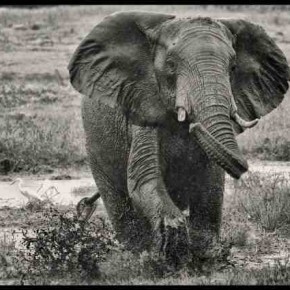 Chris Martin Photo
Chris Martin Photo
Though I’ve been traveling to Africa for 30 years, I’ve never paid much attention to how to take a good safari photo.
PSP (point, shoot and pray) has been my photographic motto.
How to take a good safari photo alluded me.
But now that I’m writing stories and posting images for my own, as well as one of Africa’s top magazine blogs, it’s time to pay attention to the quality of my pictures.
That’s why I was delighted to find Chris’ top ten list for taking better photos of animals.
Read on to find six of his suggestions I find most helpful for taking a good photo, whether you are on an African safari or not.
Chris Martin’s 6 Tips on How to Take Great Safari Photos:
1. Get familiar with the workings of your camera
Chris’ first suggestion is probably obvious, but half the people on the safaris I lead (including me) have not taken the time to know their camera.
Chris says, “You need to understand how to switch between functions almost blindfolded. Often you will need to make adjustments to your shooting settings whilst the african animal is in the frame … easy to do if you know the location of all the function buttons, impossible if you don’t.”
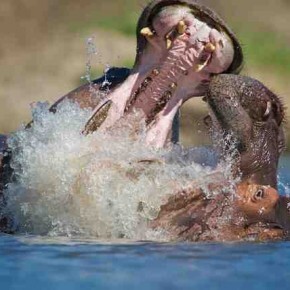 Chris Martin Photo
Chris Martin Photo
2. An image is nothing if it isn’t razor sharp
“Forget post processing and the sharpening tool. If you are sloppy with your focusing you will spoil your image. This is probably the most common fault in most images I’m asked to review,” says Chris. He suggests using a camera support: either a tripod, monopod or a bean bag (if shooting from a vehicle). “I rarely hand hold a camera when working from my safari vehicle. When you settle into position on your sighting and are getting ready to shoot, turn off the engine as even the vibrations of the vehicle can potentially ruin a great shot,” he cautions. Remembering only this one tip will help you take good safari photos.
3. Get dirty and shoot from low down
According to Chris, “Perspective is everything, and so often we become accustomed to having to shoot from above – a position that is generally unflattering. When you can, shoot from below the eye level of your subject. Try it, and see the difference.”
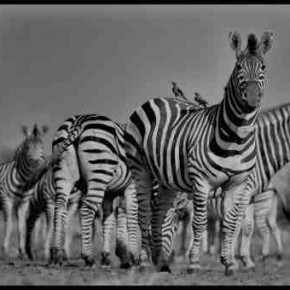 Chris Martin Photo
Chris Martin Photo
4. Consider your foreground, background and horizon
Always look at “the space behind your subject to see what else is in the image (do the same for the foreground). Consider whether you want the background to be in focus, or blurry. Be careful of sticks, branches etc in your foreground that could “grow out” of your image and potentially ruin your shot. Finally, if there is a horizon in your composition, make sure it’s straight,” says Chris.
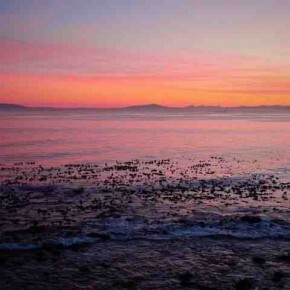 Chris Martin Photo
Chris Martin Photo
5. Grab your first shot … and compose your second
“As I approach wildlife, I always get a ‘grab shot’”, says Chris. “Once you’ve done that, move in closer and compose your next safari photos more creatively, using as many angles as possible and looking for unique ways to highlight the animals most distinctive features … even if the animal flees, you have one photo already in the can.”
The next safari photo tip will make every photo you take better.
6. The animal’s eye is your focal point:
“The expression from an animal’s eye can make or break a safari photo. You should not only have the eye as your primary focal point, but should also look to use the available light to highlight this feature and really make your image stand out. Either way, the eye is always the sharpest point of any world-class wildlife image.”
This is hard to accomplish sometimes because the animal is looking away, or the light is not right, but when you can get their eye in the right light, you will understand why this is one of the most important tips for how to capture outstanding photos on safari.
I design the photo safari workshop itineraries for Jackson, Wyoming wildlife photographer Henry Holdsworth. Join him to really take your safari photography to a whole other level.
To learn more about his next photographic safari in Africa, contact me, LoriSavingWild@gmail.com
The post Point, Shoot and Pray: 6 Best Safari Photo Tips appeared first on Saving Wild.
May 2, 2022
Giraffe Dies in Unusual Circumstances
I’m watching a spotted hyena whittle away at the slimy, saliva softened, sun-bleached jaw-bone of a dead giraffe. It’s all that remains from a giraffe that likely died after a long chase and fatal bite to the jugular. It’s predator? Probably a lion, my guide Seko tells me.
After the big cat pride had taken their fill, others – jackals, hyena, vultures – would have cleaned up the remains and chewed the bones for much-needed calcium.
Hyenas live in packs but this girl won’t announce her giraffe jaw bone prize to her clan – too much effort for very little reward. We leave her be.
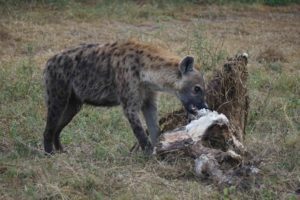 Spotted Hyena eating giraffe jaw bone.ANOTHER Giraffe
Spotted Hyena eating giraffe jaw bone.ANOTHER GiraffeA few minutes further along the dirt road, we spot another dead giraffe. “Around 25 years of age,” according to Seko, “an old male.”
We stare at the fallen being. His stomach entrails are spilled outside of its cavity (possibly the work of one hyena) but otherwise, the giraffe is intact.
Animals die in the African bush every day, but it’s rare to see a whole dead animal. Why? Because every animal is food for other animals. Sick or dead bodies are quickly and completely devoured, rarely leaving a trace let alone an entire mostly intact body.
From the looks of it, this giraffe was a lucky one. He died peacefully. For his entire life, and in his final weakened state of old age, he beat the odds. He avoided being taken down by lions, fatally kicked by other male giraffes, or killed by bush meat poachers. Highly unusual for the African bush.Instead, he laid down in this open circle of grass edged by shrubs, stretched his long neck against the earth and land he had called home for a quarter of a century, and then took his last breath.GIRAFFE FRIENDSeko says he knows this giraffe. “This male was the first giraffe I learned to recognize when I started guiding in this area about eight years ago.” There’s a sadness in Seko’s voice. He’s lost a friend.I wonder who, besides Seko (and me), notice that this great giraffe being is gone? Did he have friends, family or loved ones? Did any of them witness his passing three days earlier?
Loneliness – for the giraffe, for myself – envelops me.
Elephants continue to visit the bones of dead family members, ritualistically mingling among the remains as a part of their process of letting go of the deceased. Do giraffes have a similar ritual?
No matter, death is a solo act.
Seko’s giraffe friend had lived an elegant and wonderful life before dying with peace and dignity.
That’s the best we can hope for in our final days.Later, I wonder if the hyena we had seen realized that a few minutes walk from the jaw-bone lay a whole meal for the taking – an elegant gentle giant waiting to be reintegrated into the Botswana sand and earth from which he originated.The post Giraffe Dies in Unusual Circumstances appeared first on Saving Wild.
May 1, 2022
Becoming an Animal Communicator – Is it Real?
I’m sitting in a circle of women (and one man) in a living room lined with overstuffed chairs, small porcelain replicas of cats and dogs, and flowered wall-paper. A golden retriever sleeps at my feet, and a tabby cat wanders the room looking for friendly laps. The instructor begins the Becoming an Animal Communicator workshop with the obligatory sharing question – What made you sign up for this course?
“I recently met a woman who says she’s an animal communicator,” I begin. “Intrigued but too shy to ask what that even meant, I felt myself wishing I too could talk to animals and hear what they have to say back,” I share. I think it would be amazing to be able to talk to the elephants, cheetah, and zebra on the groups I lead for my work as an African Safari Specialist. But I can’t imagine how to do it.
“Truthfully, it seemed like the woman I met was part of a cult. I’m here purely out of curiosity,” I tell the class. I’m completely clear that entrance to this cult of animal communicators belongs to a chosen few. And I’m not one of the lucky ones.
Carol, our teacher, doesn’t resemble what I imagine a professional animal communicator looks like. She is middle-aged, and petite with no spiritual or otherwise woo woo aura about her.
“Anyone can do this,” she repeats several times. “We all have this inside of us, we just need to reconnect to it.”
After guiding the class through a couple of exercises to learn to listen to, and trust our instincts, and get out of our heads, Carol leads us in a visualization to a golden beam of light.
“This light is what we will use to communicate with the animal in the photo you are each holding,” she says. I had given a photo of my dog Zia to a participant named Kristie, and she had given me a copy of a photo of her dog Ollie.
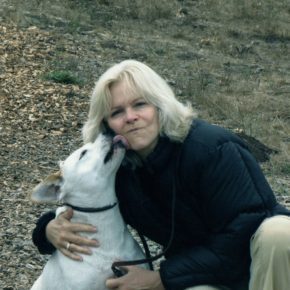
I stare at the black and white image of my ‘client’ Ollie, having no knowledge of him except gender, name and that he had recently died.
“Just write in your journal, without questioning anything that comes to mind,” Carol had instructed us.
For a few minutes I stare into Ollie’s eyes but nothing comes to my mind. I focus on blocking out my surroundings, looking as deeply as I can into Ollies’ eyes looking back at me, until I have the sensation of being inside a capsule that holds only Ollie and me.
Then I begin writing:
I miss morning time sitting on the blue sofa watching TV; I had a food bowl with little pictures of bones all over it; and I wore a red collar. Tell her it’s Ok to get another dog now.
Images and statements like these flow into my mind’s eye. I don’t question anything, I just write everything as it comes to me.
Thirty minutes later Kristie and I sit across from each other reporting on what we had written down. The purpose is to get validation, or not, about what each of us had received from the other’s animal companion.
“It felt like Ollie was there next to me,” I say, and begin with the blue sofa. I tell Kristi everything in my notes without making excuses or qualifying any of it although I’m nervous that what I’ve written is a list of nonsensical made-up statements.
Is Animal Communication Real?
Kristie confirms each of the things I read from my notes and starts crying.
I complete three different readings with different owners and pets. Each time I’m watching the animal in it’s surroundings, behaving, and giving messages that are unique to each reading. My mind searches to make sense of these experiences. How is it possible to get this information from dogs and owners I’ve never met before this moment? Is it luck that I happen to get things correct? Only after getting validation in each reading I begin to understand this couldn’t be lucky guesses. Something is happening that my rational mind can’t make sense of.
During a break in a private moment Carol tells me she rarely sees someone in her beginning classes able to be as accurate as I am with my readings.
“Maybe because you spend so much time in Africa and grew up with so many animals your abilities are still intact,” she says. “You should do this for a living,” she adds.
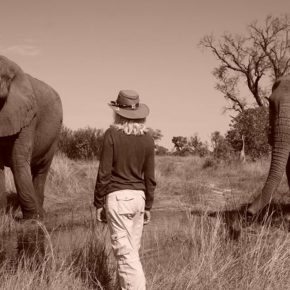
The following day I call Carol, confused. “I feel like I’m in a trance, I’m not sure what happened to me, but I feel strange. Like I’m in a dream.”
In her down to earth, this is all normal sensibility, she validates my ability, guides me out of my altered state and presents a clearer picture of what working as an animal communicator would mean.
The following weekend Ollie comes back into my mind’s eye with more messages I need to tell Kristie. Within a few months I have many referrals from Kristie posting about her experience with me on social media. And Carol and I co-design and teach a class together that includs a section on communicating with wild animals.
I have since studied with some of the top animal communicators across the globe and have come to understand that what the animal and I are using to connect is a Universal language. It’s the way animals communicate all the time. Their defaut. But for us humans it’s our least familiar way. We are born knowing it, but loose our ability (and belief in it) as we become acculturated.
Yet still, years later, before each session I have with an animal, I question my ability. I worry whether it will work this time, and whether I am making up the information that comes to me.
Only once the owner validates what I learned in my session with their human companion do I allow myself to trust. I’m told this doubt is common and will fade over time.
When I tell people I’m an animal communicator I often get a strange look. I’m assuming they think I’m part of some woo-woo cult. And that’s just fine with me.
Want more about becoming an animal communicator?
– Read about a session I did with a chicken named Butter.
– Schedule a session for your animal companion.
The post Becoming an Animal Communicator – Is it Real? appeared first on Saving Wild.



